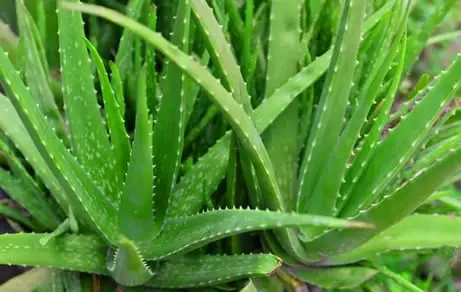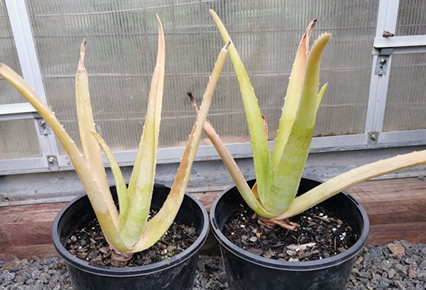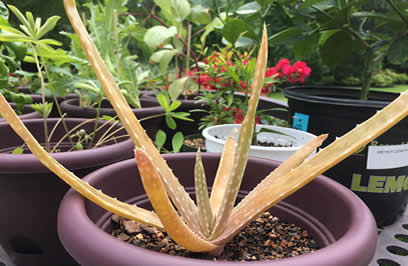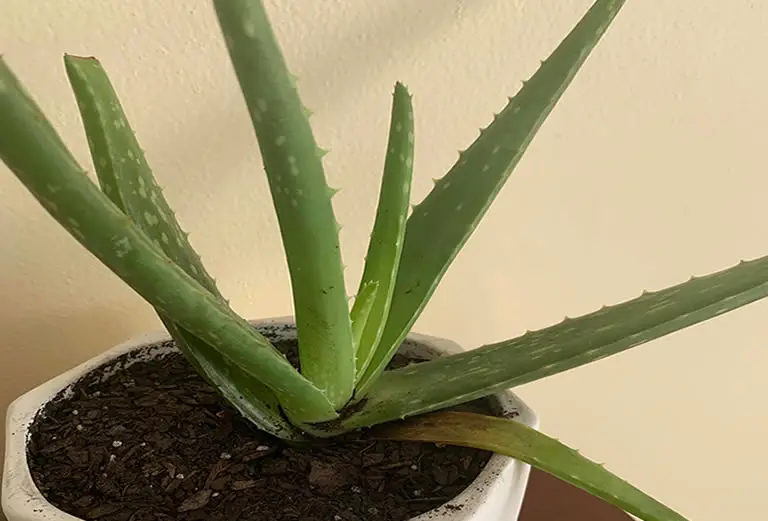In this article I cover everything you need to know about aloe plant leaves and aloe vera leaves. I outline the care routine needed for cultivating aloe plants that produce healthy, lush green leaves and I also discuss the causes of common leaf problems in aloe plants and give you their fixes.
Table of Contents
- Aloe Plant Leaves Care Guide
- The 3 basics of aloe plant care for healthy leaves
- Common Aloe Plant Leaf Problems & How To Fix Them
- Caring For & Harvesting Aloe Vera Leaves
Aloe Plant Leaves Care Guide
The aloe plant is a succulent that grows natively to the tropical areas of Africa, Madagascar, Jordan, the Arabian Peninsula and various islands in the Indian Ocean such as Mauritius, Réunion and Comoros.
Aloe plants are very hardy and are well adapted to desert conditions with scarce water resources and strong direct sunlight. So these beautiful succulents have evolved with some very specific needs that are different from most other popular houseplants in the US.
Why focus on the leaves of the plant when it comes to your care routine?
An aloe plant will always let you know if it is happy, merely content or if it is in distress, through its foliage, most notably its leaves. So in this guide I will focus on the care of aloe leaves and the treatment of the most common leaf problems that you may encounter with this plant.
Although I cover aloe vera leaves separately later in this article be aware that all the information contained herein applies to all aloe plants. So, regardless of which aloe plant you have, you can rest assured in the knowledge that the care guides that apply to one aloe plant apply to all 500 aloe plant species, including aloe vera.
The 3 basics of aloe plant care for healthy leaves
Aloe plants are easy-care succulents that require very little attention as long as the initial setup of the plant is done correctly.
Basically, if you ensure your aloe plant gets enough direct light, is growing in the correct soil and gets watered sparingly then you will have a healthy blooming perennial for many years.

Although I will cover potential leaf problems as we progress through this article I will now briefly outline the simple care routine you need to follow to have a healthy aloe plant that produces lush green leaves.
Bear in mind that getting any of the following care requirements wrong can mean a lack of aloe blooms at best and a sickly plant with damaged leaves at worst. So follow my guidelines carefully as caring for an aloe plant really requires very little effort but it must be done properly from the outset.
Using the right soil leads to healthy foliage
Aloe plants require specific soil in order to thrive. These succulents have evolved in warm and dry environments that lack the type of natural resources most plants have come to rely on.
Growing in desert areas the aloe plant can go long periods without much nutritional support and is capable of growing in rocky areas and sandy soil.
Cactus and succulent soil works best for aloe plants.
Do not pot your aloe plant in regular potting soil. Normal potting soil is much too rich in nutrients for this desert succulent and that particular will retain too much water for the plant. Always opt for a drier type of soil that has pumice or perlite as well as sand mixed in with either compost or potting soil or a similar material.
See our aloe soil guide for more in-depth information on the soil requirements for this succulent. The linked article also includes a DIY aloe plant soil mix recipe and a guide to choosing the right pots for your aloe plants.
Sunlight is essential for healthy aloe plant leaves
Although the vast majority of leaf problems in aloe plants that I have encountered are due to a poor watering routine, a close second is a poorly-lighted environment.
Aloe plants grow naturally in warm sunny areas and so they like nothing better than to bask in direct sunlight. Although too much strong direct sun can sometimes lead to a bleaching of the leaves (more on that later) by far the biggest problem for most aloe houseplants is a lack of sunlight.
The main reason why aloe plants do not bloom is down to insufficient light.
So to maintain a healthy plant with healthy lush foliage make sure your aloe plant gets at least 6 hours of direct sunlight per day. Consider using a grow light in the winter months or if you keep your aloe plants in areas that only receive indirect light.
See our aloe plant light requirements guide for more in-depth information on this subject.
The correct watering routine will help an aloe thrive (get it wrong & it could be fatal)
Ensuring your water routine is correct for an aloe plant is by far the most important part of the care routine for this type of succulent.
Having evolved to grow, and thrive, in very scarce-water-environments an aloe plant should never be overwatered.
As a rule-of-thumb to maintain healthy leaves and an overall healthy plant you should only water your aloe houseplant once every 3 weeks and it should be watered sparingly.
Water the plant from the bottom leaving it in the water for no more than 20 minutes. Alternatively, you can use the appropriate type of self-watering container or pot for this type of succulent (see soil guide linked to above).
Never wet the leaves of an aloe plant when you water it. Aloe leaves do not like to get wet. Remember this is a desert plant that has evolved in warm dry environments.
I have seen pictures of people misting their aloe plants in order to increase the humidity levels around the plant. Do not do this!
If you need to increase the humidity around your aloe plant place a saucer or tray that is filled with pebbles and a little water underneath the aloe plant pot.
Self-watering pots will automatically help maintain good humidity levels around the plant without you having to take an additional steps.
See our extensive aloe plant watering guide for more in-depth information on this subject.
Common Aloe Plant Leaf Problems & How To Fix Them
I will now cover the most common leaf problems encountered by aloe plant owners and also outline their fixes.
As with the care requirements, the problems and fixes I give below also apply to all aloe plants. This includes aloe vera.
4 Reasons why your aloe plant is turning yellow
A yellowing of aloe leaves is a very common occurrence and a concern for many aloe houseplant owners. What is the cause of this effect and what can you do to fix it? Let’s look at that now.
Aloe plant leaves can turn yellow for various reasons. Too much sun, dehydration due to a lack of water, dehydration due to root rot from overwatering, incorrect soil used and a lack of nutrients in the soil can all cause an aloe plant to turn yellow.
When you see your aloe plant leaves start to turn yellow the first thing you need to do is identify the specific problem that is causing the yellowing effect.
Below I address each potential problem, how to identify it and what you need to do to fix it.
Too much sun can bleach aloe plant leaves
Although a yellowing of the leaves can be caused by too much direct sun I have found this to be the least common cause.
Aloe plants are desert succulents that often grow in strong sunlight naturally. In fact, depriving an aloe plant of direct sunlight will result in no blooms and a plant that is far from the healthiest it could be.
Aloe plants can tolerate indirect light but they will only thrive in direct sunlight and they will never bloom without it. So, although sustained levels of direct strong sunlight can bleach aloe plant leaves yellow it is the least likely cause.

However, if your plant is getting excessive amounts of strong sunlight for many hours per day, this could be a cause for the yellowing leaves.
If this is the case for your plant then I would advise you to move it to an area that gets less hours of very strong sunlight (like a part of the house that falls into shade for part of the day).
Alternatively you could move it temporarily to an area the gets indirect sunlight.
If you choose the later course of action, and see your plant’s leaves start to take on their more natural deeper green hue again, then you will know that the plant was receiving too much strong sunlight.
However, you shouldn’t leave the plant where it is, as it will not bloom and will eventually suffer from a lack of sunlight. Instead choose a more permanent place that gets partial shade during the day and at 6 – 8 hours of direct sunlight the rest of the time.
Dehydration due to lack of water leads to chlorosis
Although aloe plants are well adapted to low water resources they are still living organism that require water from time to time. A lack of water can lead to a yellowing of the leave son an aloe plant.
Because these succulents can go long periods without water, and without showing any signs of distress, it is all too easy to neglect their watering needs. Aloe plants should never be left without water for more than 3 weeks.
Before you jump to the conclusion that your plant leaves are dehydrated due to a lack of water in the soil you need to check the soil for moisture. Use your finger, as outlined in the aloe watering guide linked to above, to test the levels of moisture in the soil.
If the soil is completely dry then your plant needs watered. Sit the plant in a bowl, or in the sink, and fill it with a few inches of water. Do not let the water reach the upper sides of the pot where it can spill into the pot and don’t let it touch the leaves.
Normally you would water an aloe plant from the bottom like this for a maximum of 20 minutes but if the soil is completely dry you should allow the plant to drink for 30 – 35 minutes.
What if the soil is not dry?
If, when you examine the soil, you find that it has some moisture in it, or if it that it is fairly wet, then the dehydration is not due to a lack of water and you need to check your plant for root rot as outlined in the section directly underneath this one.
As I outlined above, although yellowing leaves is a strong indication of dehydration this does not always mean you have been underwatering your plant. You may actually have been overwatering it!
Dehydration due to root rot will cause yellow leaves & could be fatal to the plant
I have found that when aloe plant leaves start to turn yellow due to dehydration it is almost always due to root rot. This is a very serious problem for any plant and if you identify root rot in an aloe plant you must take immediate steps if you wish to save your plant.
Root rot is fairly easy to spot as it shows clear signs in the leaves of the plant.
Look for darkened patches, or black mushy areas at the base of the leaves. If leaves come away from the plant by simply touching them this is another very strong indication that the plant is suffering from root rot.
If the above signs are not immediately apparent but the soil does contain some moisture, you will need to carefully remove your plant from its pot and examine the roots. Roots that are rotting will be blackened or be a brown color.
Root rot is a serious problem for all plants and if you feel your aloe plant may be suffering from it you should read and follow my instructions for treating aloe vera root rot as the process for identifying root rot and treating it are exactly the same for aloe plants.
Incorrect soil or lack of nutrients in the soil will lead to leaf chlorosis
Sometimes the leaves of an aloe plant will start to turn yellow simply because the plant has been potted in the incorrect type of soil with insufficient nutrients. Aloe plants like sandy soil but the soil still needs to partly contain compost or similar material.
Likewise, sometimes the soil in the pot may be the right type but it has simply been drained of nutrients over time.
Although soil problems are the least common reason for a yellowing of aloe plant leaves, I must admit that I have occasionally encountered it and so it is worth mentioning here.
The easiest way to rectify this specific problem is to fertilize the plant with succulent feed.
With an aloe plant I always advise houseplant owners to use half strength measures of fertilizer to that recommended by the manufacturer – even when using succulent feed – as this plant type requires very little fertilization. The only exception to that rule is when you are using a feed that has been specifically formulated for aloe plants or aloe vera.
Now, as I outlined with the watering routine of an aloe plant, you should be very careful before adding fertilizer to your plant. Be absolutely sure that this is the cause of the problem before you start feeding your aloe plant.
To stay on the safe side it may be simply better to repot the plant in fresh succulent soil as that way you will avoid over stimulating it with too much fertilizer.
The same 4 reasons are responsible for making your aloe plant turn white
What if your aloe plant has leaves that have almost completely lost their color and are turning white … what are the causes and fixes?
An aloe plant will turn white for various reasons. These include too much sun, dehydration due to a lack of water, dehydration due to root rot from overwatering, incorrect soil used and lack of nutrients in the soil.
The white color of the leaves is actually a loss of hue. Although this can be caused by a bleaching effect due to too much strong sunlight it is more often due to dehydration.

If you have an aloe plant with leaves that are turning white I advise you to look over the information given above which outlines the causes and fixes for aloe plant leaves that turn yellow because a whitening of the leaves is just a further progression of the same causes.
The aloe plant is experiencing a fading of leaf color which starts as yellow and ends as white if left untreated.
Basically, the causes for white leaves are exactly the same as those for yellow leaves.
However, white leaves usually indicate the problems have been developing for a longer period of time and so you must take immediate action or risk losing your plant entirely.
Revisit the above information to determine the causes and to find the fixes.
Drooping aloe leaves are almost always caused by a poor watering routine
What should you do when your aloe plant has nice green lush leaves but they won’t stay upright? What causes an aloe plant to droop?
A drooping aloe plant is usually an early indication of watering problems. The plant may have been underwatered or underwatered. Other potential causes are root rot and pests. If immediate action is not taken the leaves will eventually turn yellow or brown and the plant will die.
When the leaves of an aloe plant start to droop and fall over, this is an early indication of a problem.
Taking action at this point will save you a lot of heartache and trouble later on. If you wait to fix the problem you will have more problems to fix.
The biggest cause for drooping aloe plant leaves in my experience lies in a poor watering routine.
Although underwatering can cause a drooping of aloe plant leaves the most common culprit of a drooping aloe plant is overwatering. Excess water in the soil is soaked up by the leaves and they become too heavy to stay upright.
The first thing you should do is check the soil for moisture levels.
If the soil is completely dry you should water the plant taking into consideration all the concerns I noted above in the section on dehydration (be absolutely sure the plant has not been overwatered before giving it more water).
Always ensure the pot an aloe plant is in has good drainage.
If the plant is in heavily drenched soil it should be reported immediately and you need to check it for root rot (see section above Dehydration due to root rot). If the soil is just moist then you will also want to check the plant for root rot or for signs of pests or disease.
Also check that a drooping aloe plant is getting sufficient light.
As I have already outlined this succulent needs at least 6 hours of direct sunlight per day. If your plant is not getting enough light then you may need to move it to a more sunny local or move it from spot to spot during the day, essentially following the sun, until it recovers.
When the leaves show signs of recovery you should place the plant in a more permanent sunny location that gets at least 6 hours of sunlight per day. You should also consider using a grow light to make up for any difference between the natural light available and the light needs of the aloe.
Other potential, but less common, causes for a drooping aloe plant are pest infestations and disease that lead to dehydration from root rot.
If disease is causing the root rot then the fixes are the same as those already mentioned for the treatment of root rot.
If pests are causing the problem you should treat the plant with a good insecticide and once the pests have been eliminated you should repot the aloe in fresh soil and a new container/pot be sure to remove any damaged roots from the plant before repotting.
Caring For & Harvesting Aloe Vera Leaves
Although aloe vera leaves require the same care routine and suffer from the same problems as other aloe plants I will address the care of this species of aloe plant specifically because it is by far the most popular aloe houseplant in the US.
I have also included information on aloe vera leaves specifically because many aloe plant owners are unaware that their aloe vera plants require the same care as other aloe plants and so they seek specific information regarding aloe vera – not knowing that any advice given for other aloe plants will apply equally well to their aloe vera.
I have also included aloe vera leaf information because many visitors will land directly on this section of the article from a web search due to the way search engines now currently operate. Just be aware that the information given above for aloe plants applies to aloe vera plants as well.
So without further ado let’s look at aloe vera leaf care.
The basics of aloe vera leaf care
Leaf care for aloe vera is exactly the same as the leaf care for aloe plants that I outlined at the beginning of this article.
Essential care requirements for aloe vera:
- An aloe vera plant must be grown in the correct soil.
- You must maintain a proper watering routine.
- The plant at least 6 hours of direct sunlight per day.
To keep your aloe vera healthy just remember that aloe vera is just a specific species of aloe plant and doesn’t require any addition or special care compared to other aloe plants. What is good for one aloe plant is good for all aloe plants. What is bad for one aloe plant is bad for all aloe plants.
However, I will address some issues, concerns and questions that I get specifically from aloe vera users below.
How to harvest aloe vera leaves for their latex
Many aloe vera plant owners wonder if they can cut a leaf off their aloe vera plant. Why do this?
Well some aloe vera houseplant owners have heard of the medicinal and skin benefits of aloe vera gel and so want to harvest the latex (the gel within the leaf) for use in home remedies and to use as part of their skin care routine. So can you cut a leaf of an aloe vera plant?
You can cut the leaf of your aloe vera plant. The cut will seal by itself and the plant will remain unharmed. Just be sure not to cut all the leaves off. Allow a new leaf to grow before cutting another mature one.
For more information on aloe vera leaf cutting see my ultimate guide to cutting aloe plants which gives you step-by-step instructions on how to cut an aloe vera leaf from the plant and how to harvest the latex it contains.
How an aloe plant reacts to losing foliage & how to use it to your advantage
Many aloe vera houseplant owners grow their plants so that they can cut the leaves and harvest the latex contained within. But once you cut a leaf from an aloe vera will it grow back?
When you a cut a leaf from an aloe vera plant the leaf will not grow back. However, new leaf growth will appear at a different part of the plant as long as the plant is healthy and properly cared for.
Although an aloe vera plant will not suffer from leaf cutting you should only cut as much off the plant as you need. Cutting all the leaves off an aloe plant in one go, or at intervals that are very close to each other, is not advisable.
Once you cut a leaf from an aloe vera plant wait until new leaf growth takes it place at a different place on the plant and allow the leaf to mature before removing any more of the foliage.
If you wish to harvest the latex from aloe vera leaves regularly, you should keep multiple plants.

